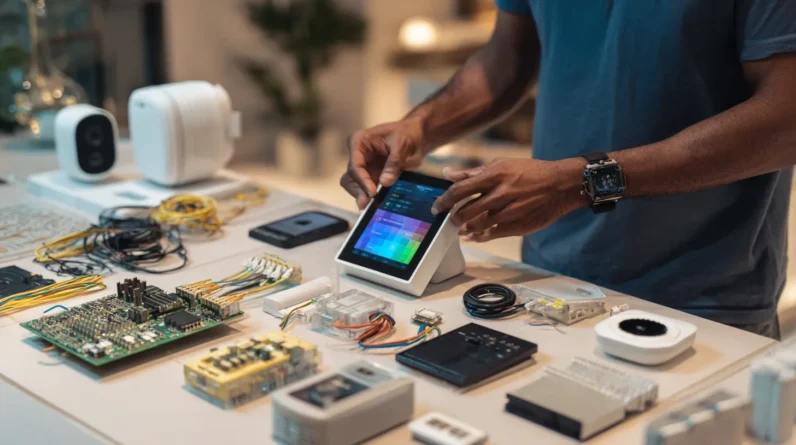
We’re taking steps to secure our smart gadgets to protect our families’ sensitive information and prevent potential breaches. To start, we’re changing default usernames and passwords on all devices, creating strong, unique passwords, and enabling multi-factor authentication where possible. We’re also regularly updating firmware and Wi-Fi passwords to address vulnerabilities and monitoring device activity for unusual behavior. Additionally, we’re using strong encryption protocols, such as WPA3, to enhance our Wi-Fi network security and creating a separate network for IoT devices to isolate them from primary devices. By taking these measures, we’re just beginning to safeguard our connected homes.
Essential Security Measures
To safeguard our smart gadgets and protect our family’s sensitive information, we must take proactive steps by implementing essential security measures that address the inherent vulnerabilities of these devices. One important step is to change the default usernames and passwords on new smart devices, as these settings are often easily exploited by hackers. We should create strong, unique passwords for each device and enable multi-factor authentication (MFA) on supported devices. Regular updates for our devices’ firmware and Wi-Fi passwords are also critical, as they address potential vulnerabilities and protect us against the latest threats. By taking these measures, we greatly reduce the risk of unauthorized access and data breaches. Monitoring device activity for unusual behavior helps identify potential security breaches early, allowing for swift action to protect our sensitive personal information.
Protecting Your Wi-Fi Network
We can greatly boost our home network’s security by implementing robust Wi-Fi protection measures, starting with the use of strong encryption protocols and complex passwords. Utilizing WPA3 encryption and setting a unique Wi-Fi password that combines letters, numbers, and symbols can markedly enhance our network’s security. We should also create a separate network for IoT devices to isolate them from primary devices, reducing the risk of exposing sensitive data and functionalities. Regularly monitoring network traffic helps identify unusual activity, allowing for prompt action against potential security threats. Additionally, disabling SSID broadcasting makes our network less visible to outsiders, further protecting it from unauthorized access attempts. By taking these measures, we can guarantee a secure smart home and protect our family’s privacy and security.
Managing Device Vulnerabilities
By securing our home network, we’ve taken a significant step in safeguarding our smart gadgets, but our work isn’t done – we must also manage device vulnerabilities to prevent hackers from exploiting weaknesses in individual devices and gaining access to our network. We must regularly update device firmware to address known vulnerabilities and guarantee all security patches are applied. Changing default usernames and passwords on all devices is also essential, as default credentials are easily exploited by hackers. To further mitigate security risks, we should disable unnecessary features and utilize reputable security software to monitor for potential vulnerabilities in our smart home devices. By taking these steps, we can effectively manage device vulnerabilities and protect our connected home from unauthorized access.
Securing Your Smart Home
Securing our smart home requires a proactive approach, as the ever-evolving landscape of IoT threats demands constant vigilance to protect our connected devices and sensitive data. To secure your smart home, we must take several key steps. First, we change default usernames and passwords on all IoT devices, replacing them with strong, unique passwords. We also create a separate network for our smart devices, isolating them from our main network and protecting our personal information. Regularly checking for firmware updates is essential, as is staying informed about potential vulnerabilities. By taking these steps, we can greatly reduce the risk of unauthorized access and protect our home and personal information from potential threats.
Best Practices for IoT Security
To further fortify our smart homes, implementing best practices for IoT security is the next logical step, as it enables us to safeguard our devices and data from an increasingly sophisticated threat landscape. We must change default usernames and passwords on all IoT devices to prevent compromised credentials. Regular firmware updates help guarantee our devices aren’t vulnerable to security breaches. We also recommend implementing two-factor authentication where available to add an extra layer of security. Creating a separate Wi-Fi network for smart gadgets helps limit potential damage from compromised devices. By following these tips to help secure our IoT devices, we can enjoy the convenience of a connected home without putting our data at risk. Strong security measures are essential in protecting our Internet of Things devices from cyber threats.
Conclusion
We’ve outlined the critical features for ensuring smart gadget security for our families. By implementing essential security measures, protecting our Wi-Fi networks, managing device vulnerabilities, and securing our smart homes, we can markedly reduce the risk of cyber threats. For instance, the 2017 Mirai botnet attack, which exploited unsecured IoT devices, highlights the importance of regular firmware updates and strong passwords, as seen in the case of a homeowner who avoided the attack by simply changing their router’s default password.







